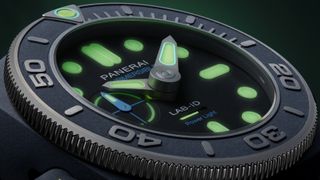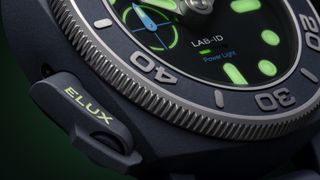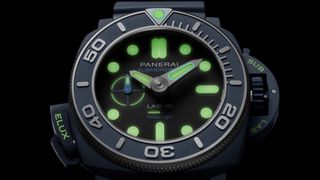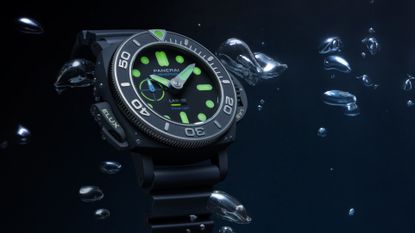When you think of innovation among the best watches on the market, chances are Panerai isn't a name which springs to mind. That's not a mark of disrespect, either. The brand is instantly recognisable and still produces staggering dive watches regularly.
That's all about to change though. Today, the brand unveiled the Panerai Submersible Elux LAB-ID – and it's the single most technologically advanced watch I've ever seen.
The watch features a whopping 49mm case, crafted from a material called Ti-Ceramitech. That's a titanium alloy with a ceramization process applied. That gives the material its signature blue hue, too.

While the case diameter may make you wince, it certainly brings its share of benefits. Case in point – there is 500m of water resistance on offer here, which is more than enough for most users.
"So far, so ordinary," I hear you cry.
Well, fear not – the real magic happens on the inside. There, you'll find the P.910/EL calibre, which offers a 4Hz beat rate, three days of power reserve – oh, and a small electrical circuit to power a light for 30 minutes.
Confused? So was I. Fortunately, I had the pleasure of sitting down with Panerai's R&D Director, Anthony Serpry, who explained it in greater detail.
How does the Panerai Submersible Elux LAB-ID work?
In essence, the watch movement works just as you'd expect. A rotor spins to wind power into a barrel which is released as power. In this case, though, there are a total of six barrels inside the watch.
Two of those are used for timekeeping, with the remaining four powering a small electronic circuit. That, in turn, can offer 30 minutes of Power Light, which illuminates the bezel, hands and indices. Users can turn that on and off via a pusher at the 8 o'clock position.
Still, that wouldn't have just worked with any old off-the-shelf movement. Feeding six barrels adds a lot of resistance into the movement, which requires added torque to get it moving. "The rotor is 3.4x heavier than normal movements," says Serpry, which gives the precise amount of torque required to power the movement.

Once you have that power stored, it travels along a small electronic circuit, to deliver the power into the areas of the watch which need it. That presented the first challenge for the brand.
Most of the parts they wanted to light up – the hands and bezel, specifically – are moving parts. The challenge came from trying to ensure that power could still be delivered, even when pieces move to different locations.
The result is a combination of magnets, mini LEDs and magic, which allows the light to be directed only to where it is needed at any one time. It's a marvel to behold.
The hands presented a similar issue. There, the brand tested a design similar to how the speedometer works in a car. That shines a light into a reflective area, but was deemed not good enough for this piece.
Instead, a complex array of very specifically located electricity tracks take power from the movement to the specific hand. There, mini LEDs are welded onto the hands, to illuminate them.
Can this technology go further?
For me, this feels like a real turning point. We've seen smartwatches grow in popularity over the last decade, with popular models even outselling the entire Swiss watch industry combined.
They certainly have a shelf-life, though. The technology inside them improves rapidly, making models obsolete after just a few years. On top of that, the batteries used will degrade over time, making them less and less useful.
That could all be solved with this system. No more batteries, simply kinetically wind your watch and enjoy all of the same benefits.

It's a sentiment which was echoed when I asked Serpry if this was a sign that Panerai would bring an entirely mechanical smartwatch to market in the future. "Never say never," he chuckled, "but for us, it's crucial to make sure the product doesn't become obsolete."
Instead, Serpry had a much more modest outlook for the next ten years. "I'd like to work on further scaling down the elements to reduce the size. It's important to ensure that durability is never compromised, too."
That's something which is really key to the brand. "This is not just a concept," Serpry tells me as we're wrapping things up, "this is made to be used, and tested to exactly the same standards of every other Panerai product."

With just 50 units set to be produced each year for the next three years, and an eye-watering £92,400 price tag, this is certainly an enthusiast pick up. Still, it's one which might just be worth its weight in gold.
Talking about this watch felt like a momentous occasion. Like the moon landing or the first iPhone, this feels like a turning point for the technology it uses.
In thirty years, when everyone is wearing their mechanical smartwatch, I'll smile fondly and say, "I remember where that all began – the Panerai Submersible Elux LAB-ID."



